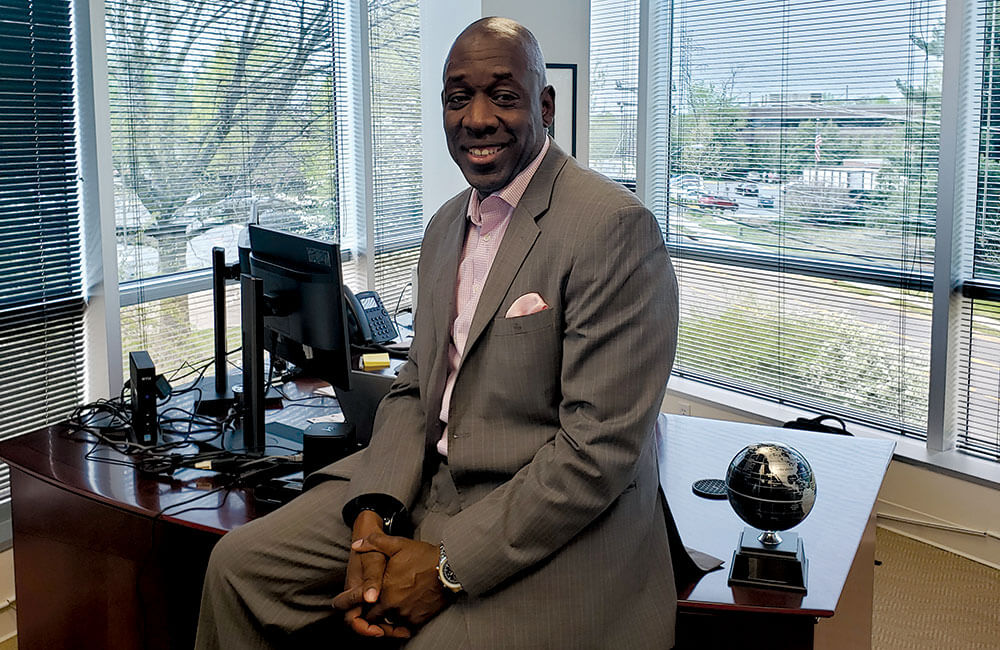
Johnnie White, in his office at the American Society of Appraisers, said he always believed he could be a CEO. (Courtesy Johnnie White)
When Johnnie White arrived at the American Society of Appraisers (ASA) office on April 15 — his first day on the job in his new role as CEO and executive vice president — it felt like it had been several decades in the making. That’s because if you had asked him about the potential to be a chief executive officer when he was doing membership data entry at the American Institute of Aeronautics and Astronautics (AIAA) in 1992 — White’s first job — he would have told you that he already had his eye on the prize.
“I’m a very goal-oriented person,” White told Convene. “When I first started [at the AIAA], I watched the CEO and thought to myself, ‘One day, I think can do that.’”
White recognized that the ascent to CEO meant playing the long game, and early on in his career, he identified a need to expand his network. “I spent a great deal of time volunteering at PCMA and ASAE,” White said. “But my focus wasn’t just on the national level. I dedicated time on the local level to give me a network within throwing distance, too.”
In addition to meeting more peers and finding mentors through those organizations, White invested time in studying how associations work, and “how to be a strategic thinker,” he said. “I also wanted to understand the concepts that shape adult learning. At one point, I went back to get my master’s degree in adult education. After I took a break, I wound up getting my MBA, and my studies gave me a rounded view that included leadership, business, finances, and marketing.”
Telling His Story
Taking on high-pressure responsibilities is nothing new to White. Over the past 17 years, he has played integral roles at The Endocrine Society, the Cardiovascular Research Foundation, and the American Academy of Otolaryngology, managing teams of more than 40 staff members, overseeing budgets of $25 million, and doing much more than the logistical work associated with meetings and events. As more meeting professionals strive to have a greater role in the strategic planning of their respective organizations, White said that much of that relies on crafting a personal narrative.
“You have to build your story to your CEO or whoever you’re reporting to for them to understand your true value,” White said. “It’s the same concept as a being a movie star. You have to help those in charge understand the net value or the net worth of what you bring to the table.”
You can’t write that story without being “willing to take risks,” White said. “You obviously want to minimize those risks, so use data to help inform the decisions. But if you can continue to take those risks for the organization and be successful, people will start to notice and start to pay attention to you.”
Going Global
One of the most rewarding risks in White’s career has been betting on the value of stepping outside the U.S. That’s not always an easy sell in the American nonprofit landscape where organizations are often more focused on pre- serving their existing audiences than in expanding into territories with different languages, different currencies, and different ways of doing business.
“As I look back at my career so far, I’m most proud of my focus on helping organizations adopt a global mindset,” White said. “With the Endocrine Society, I was the first to develop a program outside the U.S., and it was a huge success. When I went to the Cardiovascular Research Foundation, I helped expand their footprint internationally, too. We strategized and looked at Brazil, Russia, India, and China. Focusing on those areas helped expand into other countries.”
Likewise, one of White’s top priorities at ASA will be to look at opportunities to partner with groups outside the U.S. and make the organization more global. He acknowledged, though, that he will definitely have a “learning curve.” He’s spent the bulk of his career building communities in the health-care space, and ASA’s members don’t do any work in hospitals, research facilities, or patient-care settings. But he’s counting on his appetite for learning to see him through.
“I’m like a sponge,” he said. “I try to absorb as much as possible about the profession to be able to lead the organization, and I will take that same tactic. I’ll talk to members, non-members, sponsors, and all the stakeholders to get an idea of what they think about the profession.”
CEO Who Knows How to Cheer
Another group with whom he’ll devote much time to conversation: everyone else in the ASA office. “When you’re in a busy leadership position, taking time to hear from the staff is essential,” White said. “They appreciate the effort.”
When White served as CRF’s executive director in New York, one simple habit ensured that he regularly connected with those who reported to him.
“We all have to have lunch,” White said. “No matter how busy you are, you have to eat. On Fridays, I would regularly ask one staff member to go to lunch, and they could share anything they wanted to from a personal or a professional standpoint.” The lunches were very informal, he said, “but they offered the opportunity to build a relationship. That goes a long way.”
Whether or not those Friday lunches become a regular practice for White at ASA, getting to understand how he can support his staff will take top priority. “What makes a great leader is understanding when to lead, but equally importantly, it’s about understanding when to be a cheerleader,” he said. “I’m a good cheerleader, and I will continue to do that.”
David McMillin is a Convene associate editor.
